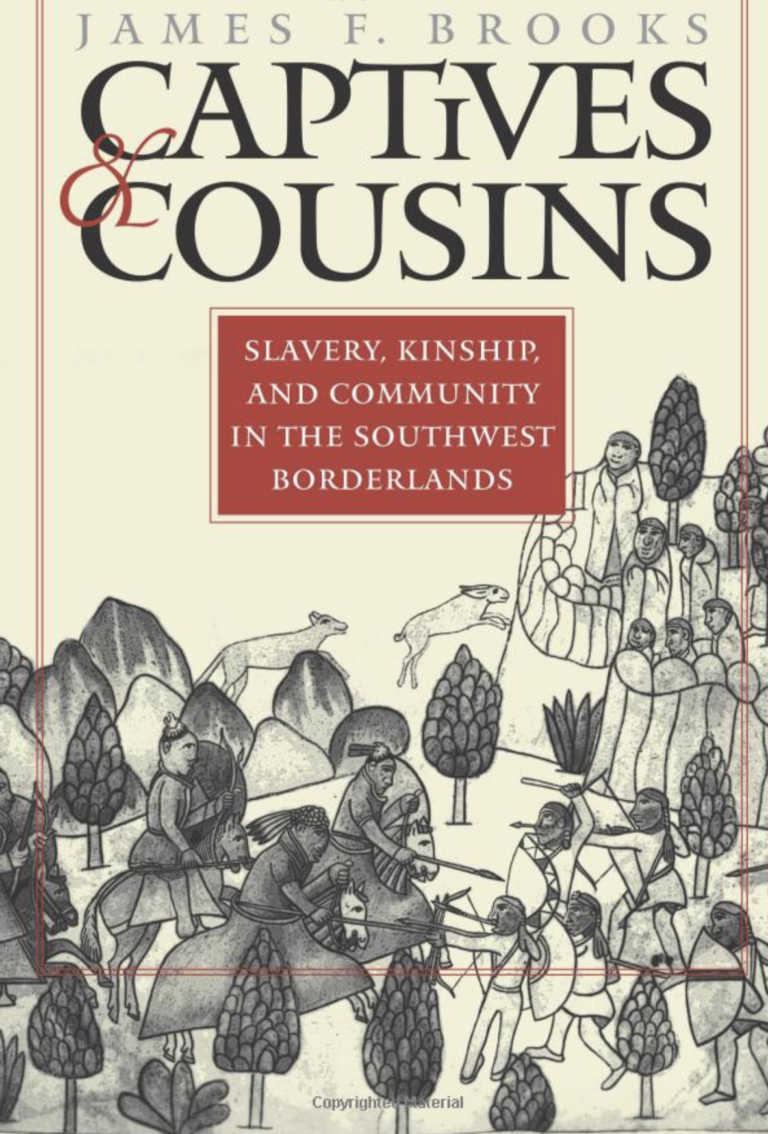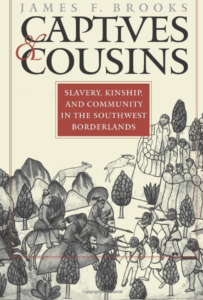Borderlands Bondage

James F. Brooks, Captives and Cousins: Slavery, Kinship, and Community in the Southwest Borderlands. Chapel Hill: Published for the Omohundro Institute of Early American History and Culture, Williamsburg, Virginia, by the University of North Carolina Press, 2002. 419 pp., cloth $55.00, paper $22.50. Review by Jennifer M. Spear The ricos [rich] have peons or slaves, just as they have in the South, except they are Indians
—Samuel Yost, U.S. agent to the Navajos, Zuñis, and Hopis, letter to the editor, Sante Fe Weekly Gazette, September 9, 1858
In the spring of 1874 on the banks of the Rio Chama northwest of Santa Fe, a band of Weeminuche Utes encountered a group of New Mexicans seeking a place to settle. But in the fluid space of the borderlands, connections between these groups were far more complicated than calling them “Utes” and “New Mexicans” would indicate. Among the New Mexicans were a Ute raised in captivity by New Mexicans and a New Mexican raised in captivity among the Utes until his family were able to ransom him. Cultural familiarity, if not in this case ties of kinship, connected these Utes and New Mexicans, enabling the latter to establish themselves peacefully in Ute territory. Uncovering the histories of captives like these, of their movements among diverse communities of indigenous and Euro-American inhabitants of the borderlands, James F. Brooks demonstrates how, as slaves and kin, people and capital, whether exchanged in violence or in marriage, borderlands peoples were bound together by captivity for more than three hundred years.
Taking a regional approach, Brooks reveals complex and multifaceted stories of captivity and violence, of fictive and biological ties across ethnic and “tribal” boundaries. As the meeting on the banks of the Chama illustrates, this is not a story of Europeans against Indians or even a Spanish-Pueblo alliance against what contemporary Spaniards called indios bárbaros(barbarous Indians). Working against historical interpretations that, in order to clarify the story, categorize the actors into simplistic groups, Brooks reminds us that it was precisely during these moments of contact and colonization that national and tribal identities such as New Mexican, Comanche, and Navajo came into being.
In order to make some sense of these stories, Brooks divides the Spanish borderlands into three ecologically defined borderlands: “the buffalo plains, the canyons and mesas west of the Río Grande, and the mountain ranges that linked them” (164). In each, Indians and Euro-Americans alike were bound together by similar economies—a trading-and-raiding economy on the plains, pastoral sheep-raising in the canyons and mesas—and by the capture and exchange of people that defined the political economy of the entire borderlands region. He then traces out how each of these borderlands was first touched by colonialism, then slowly incorporated into a capitalist economy, and finally subjected to U.S. pacification policy, carefully demonstrating how each of these processes could play out in a myriad of ways both between and within various groups. Take horses, for instance. For Kiowas, the acquisition of horses bolstered their system of social rank as horses improved a noble family’s ability “to give generously of its wealth in horses, to mount noteworthy military efforts in pursuit of horses, honor, and revenge, and to maintain a handsome and dignified demeanor in daily affairs” (171). Comanches, on the other hand, retained their commitment to “political egalitarianism and personal autonomy” (174) even as horse ownership was less equally distributed among them than among Kiowas. Or sheep, for another example. As with Comanches and horses, some Navajos acquired far more sheep than others, a development that led to the emergence of a nascent class system and even to distinct band identities.
Alongside horses and sheep, captives moved throughout the borderlands economies. Captivity served many purposes. It provided sacrificial subjects for the Morning Star ceremony of the Skiri Pawnees and replaced kin lost to conflict or disease. It generated workers who processed skins for market, herded sheep, and worked as domestics primarily in New Mexican households. It produced hostages who could be ransomed for peace or profit and, perhaps most importantly, women who could become wives. Captivity also had many different meanings. For some, captivity was only a temporary situation, while for others, it fully integrated them into a new kinship network or household, whether through marriage, adoption, or compadrazgo (Catholic godparenthood). For many, perhaps most, it initiated a period, if not a lifetime, of servitude or slavery. These experiences of captivity were not mutually exclusive. Many of those held captive by New Mexicans were baptized and had godparents who were putatively their owners.
As practiced in the borderlands, slavery was not a condition that was clearly distinguished from other categories of dependency or semiservility, nor was it based on a “racial dichotomization” (364) between slaves and their owners, nor was it one that precluded “mobility between statuses” (244). Similar in form to slavery in many African societies, slaves in the borderlands could be fully incorporated into their owners’ families, mediating some of slavery’s more exploitative features and making for a much more fluid system in which one’s status could be changed. As Brooks reminds us in his depiction of borderlands slavery and his comparative references to African slavery, Southern chattel slavery was the exception, not the rule. Ironically, of all the borderlands systems of bondage, slavery among the pastoral Navajo developed into an institution that was the most like chattel slavery. While New Mexican slaveholding was widely dispersed with many families owning a slave or two, among Navajos a slaveholding class emerged, with some headmen owning thirty or more slaves. In addition, over the first half of the nineteenth century, some Navajo began to distinguish more sharply between themselves and their slaves, ceasing to consider them eligible for adoption or other forms of incorporation.
Captives and Cousins is a thoroughly researched and richly detailed history of the multivalent consequences of the spread of colonialism and capitalism in North America. Illustrating the complicated and at times confusing nature of contact and captivity in the borderlands, Brooks brings Richard White’s microhistorical methodology to the southwest while heeding Ira Berlin’s call to complicate our understanding of slavery in North America. In doing so, Captives and Cousins has succeeded in bringing together the two most vibrant subfields of early American history: cultural contact and slavery.
Further Reading: See Richard White, The Middle Ground: Indians, Empires, and Republics in the Great Lakes Region, 1650-1815 (New York, 1991); Ira Berlin, Many Thousands Gone: The First Two Centuries of Slavery in North America (Cambridge, Mass., 1998). For a more panoramic view of the southwest borderlands, see Elizabeth A. H. John, Storms Brewed in Other Men’s Worlds: The Confrontation of Indians, Spanish, and French in the Southwest, 1540-1795 (Norman, Okla., 1996).
This article originally appeared in issue 3.2 (January, 2003).
Jennifer M. Spear is an assistant professor of history at the University of California, Berkeley. Fascinated by the contexts and consequences of cultural encounters in early America, she is currently writing a history of racial formation in colonial New Orleans.
